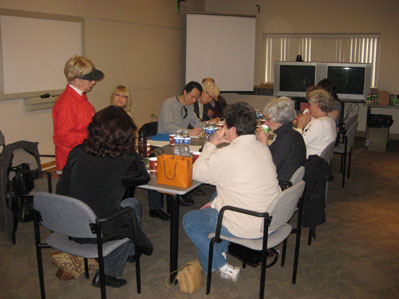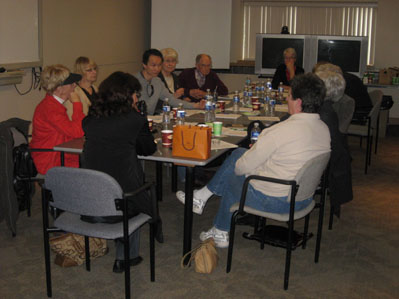BEBCRF Support Group Meeting – Vancouver, Spring 2009
Sharing Information
Session Leader:
Barbara Debryun
On Saturday, February 21, 2009, Vancouver held their Support Group meeting. The main topic of the day was Sharing Information. Some of the topic headings were Each Member's Journey, Obstacles to Living and Resources or Tips for Survival. All of the members attending participated in the meeting. Each member was asked to contribute by relating his or her experience with the topic headings as a guide.
Barbara Debruyn, RPN
Barbara Debryun, as a member of the Vancouver Support Group, volunteered to lead their first session at sharing concerns, trials and tribulations. To do this effectively Barbara provided each member with a list of topics to be discussed and related information that she has been able to glean over time that could help the others present. She initiated each topic by relating her own personal experience and then asked the others to do the same.
Each Member's Journey was the first topic heading and Barbara stated that it takes some time to be diagnosed with the various types of focal dystonia. Personally she had expected a thorough exam with a conclusive diagnosis, and, had expected to be provided with such pertinent information as treatment options, possible side effects, and possible outcome. Instead she found that many physicians (GPs) were just as much in the dark as she was.
One of Barbara's handouts was entitled "The Strategy Behind Treating Dystonia" which summarized some of Dr. Joseph Jankovic's strategies for diagnosing and treating the various forms of dystonia. In it is listed some of the medication that may be used for BEB and Meige. As the article was reviewed the Group shared information concerning their specific types of medication. It was soon realized that everyone not only reacts differently to the medication but that it can be difficult to find the right one and the correct dosage.
 Barbara Debruyn standing and Attendees.
Barbara Debruyn standing and Attendees.
Barbara considered the mental health aspect of coping with the disorder due to the significant changes to one's level of functioning and independence resulting in possible depression, and, the need for social workers/counselors that are educated on the topic to be available for those that may need them. She mentioned that some medical specialists do have these people available for their patients.
She emphasized that BOTOX® injections are not enough for there are many aspects of our lives that are affected. Patients have questions and need answers and support. With this statement she launched into the next topic heading Obstacles to Living.
One has to learn how to deal with the decreased ability to drive, read, watch TV and use the computer. Even such basic chores as cooking and home care become more difficult to deal with. One is now faced with the impact of the disorder on various social aspects of their lives, and, failure to deal with this can often lead to isolationism. The biggest obstacle is the need to learn ways to manage functional changes and still maintain optimum independence.
Barbara handed out a sheet entitled Resources and Tips for Survival. The Canadian National Institute for the Blind (CNIB) as well as the local library where listed as a resource. For those times when your vision is really bad, the CNIB will help with such things as cooking safely, seeing expiration dates on food, walking and, will do a home assessment as well as give safety tips.
The local library has books on tape and/or CDs, large-print books and e-books that may be downloaded onto your MP3 player. For those that can use a computer Barbara recommended some sites to visit and some tools that would help with their use.
 Deep in Discussion.
Deep in Discussion.
Barbara uses a free download that she got from www.naturalreaders.com to read aloud anything on the computer screen, web pages, email and so on. It also can be set up to read aloud as you type. She had a tip for those who still use the computer and that is to put Velcro dots on the end keys of the home row. This helps her to know where she is starting from when she types.
She suggests that the various bulletin boards are a good way to share ones frustrations and problems somewhat anonymously. The Dystonia Bulletin Board is a good one because it will allow you to link to the Blepharospasm Bulletin Board. Barbara states that the computer is a good source of information and once you link to one site it will often take you to other sites worth looking at.
She suggested that, for those patients that could not get to the meetings because of distance, they may want to find out if they can get to a dystonia support group meeting because some of them are BEB oriented. To find one close to you please use the "Links To Other Resources" (on this page) to go to Dystonia Canada and then select "Support".
Barbara found that going to the UBC clinic was somewhat difficult and found an ophthalmologist willing to perform the injections closer to home. However, she did find it a bit more expensive because it is not a 'clinic' with lots of people to share the 100ml vial. She thinks that the vial may be too large for one individual and wonders if Allergan can reduce the size for cases such as hers.
More importantly she feels that there should be someone to call when there are side effects or no effect from the treatment. To wait until the next one is too long a wait. It is easy to understand why the specialist may not want to see a patient in between treatments because there is nothing he or she can really do. Therefore, if one is to turn to his or her family doctor (GP) for care other than the injections, then the GPs need to have more information.
Barbara concluded that doing all of the above as early as possible would in many cases alleviate if not avoid many of the frustrations brought on by this disorder.
BOTOX® is a registered trademark of Allergan Corporation

